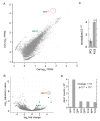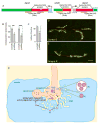Retrovirus-like Gag Protein Arc1 Binds RNA and Traffics across Synaptic Boutons
- PMID: 29328915
- PMCID: PMC5793882
- DOI: 10.1016/j.cell.2017.12.022
Retrovirus-like Gag Protein Arc1 Binds RNA and Traffics across Synaptic Boutons
Abstract
Arc/Arg3.1 is required for synaptic plasticity and cognition, and mutations in this gene are linked to autism and schizophrenia. Arc bears a domain resembling retroviral/retrotransposon Gag-like proteins, which multimerize into a capsid that packages viral RNA. The significance of such a domain in a plasticity molecule is uncertain. Here, we report that the Drosophila Arc1 protein forms capsid-like structures that bind darc1 mRNA in neurons and is loaded into extracellular vesicles that are transferred from motorneurons to muscles. This loading and transfer depends on the darc1-mRNA 3' untranslated region, which contains retrotransposon-like sequences. Disrupting transfer blocks synaptic plasticity, suggesting that transfer of dArc1 complexed with its mRNA is required for this function. Notably, cultured cells also release extracellular vesicles containing the Gag region of the Copia retrotransposon complexed with its own mRNA. Taken together, our results point to a trans-synaptic mRNA transport mechanism involving retrovirus-like capsids and extracellular vesicles.
Keywords: Arc/Arg3.1; Gag domain; RNA trafficking; RNA-binding protein; exosomes; extracellular vesicles; plasticity; retrotransposon; synapse; trans-synaptic RNA transport.
Copyright © 2017 Elsevier Inc. All rights reserved.
Figures







Comment in
-
A Viral (Arc)hive for Metazoan Memory.Cell. 2018 Jan 11;172(1-2):8-10. doi: 10.1016/j.cell.2017.12.029. Cell. 2018. PMID: 29328922
-
Cell biology of the neuron: ARC goes viral.Nat Rev Neurosci. 2018 Mar;19(3):120-121. doi: 10.1038/nrn.2018.9. Epub 2018 Feb 1. Nat Rev Neurosci. 2018. PMID: 29386612 No abstract available.
References
Publication types
MeSH terms
Substances
Grants and funding
LinkOut - more resources
Full Text Sources
Other Literature Sources
Molecular Biology Databases

